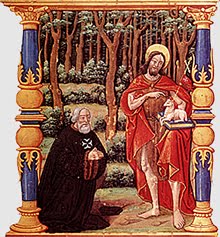"How the Rule of Blessed Raymond can bring out your inner monk"
a review by William Cash, published in the Catholic Herald today.
A short book on the Rule of Blessed Raymond du Puy, one of the early 12th-century founders of the Order of St John, an ancient religious and military order, sounds like an unlikely sleeper publishing hit. But if you go onto the website of Etsy, you will see that this beautiful slim red volume, which has the feel of a small missal, is in the bestseller section.
In an age when self-help books devoted to the cult of self-improvement sell millions, it’s refreshing to see that there is also a market for books devoted to the charism of spiritual reflection and detachment fromself. This spiritually enriching manual on how to be a Christian pilgrim-knight – in manners, spirit, diet (two meals a day, with wine) and even dress (fur is vulgar and off-limits) – is a call to arms for anybody wanting to reclaim their inner monk.
“We printed 1,000 copies of this book, which I imagined would languish in my attic for a few years. We are now looking at a reprint,” modestly says Fra’ Max Rumney, procurator of the Order’s Grand Priory. “This popularity is a curiosity and a little miracle.”
At a time when we all probably spend too much time looking at our phones and other screens, the book is really a reinterpretation of the original 12th-century rule for the modern age. This is all largely thanks to the quirky and idiosyncratic philosophy of the author, the late Father Jerome Bertram of the Oxford Oratory, and Fellow of the Society of Antiquaries, who died, aged 70, in 2019, just before this book was published. Like many devotional books of spiritual guidance, the best reveal as much about the author, or translator, as the subject.
Blessed Raymond was a noble French crusader knight whose paintings depict him with a crucifix in one hand and a sword in the other. The structure of the book is to cleverly take up an anachronistic point from Raymond’s 12th-century rule and make it relevant to today. Jerome makes it clear that the Catholics should celebrate the aesthetic and liturgical riches of the faith. “Zoom Masses leave some of us unmoved,” says Fra’ Max, speaking up or many of today’s “professed knights”.
He speaks with authority on the subject of turning off one’s phone as he didn’t own such a device. Fr Jerome’s mantra is that we need not just switch off our phones – to get closer to communion with our inner souls – but also sometimes switch off from the “moronic inferno” of the 21st century. Written around 800 years before the modern digital age of 24- hour news cycles and Twitter, Fr Jerome advises that “the practice of silence is even more important in our own day than in the past”. Instead of taking Blessed Raymond’s idea of silence at meals literally, he suggests that reading at meals, if alone, is better for the soul than having some soap opera or game show blaring in the background.
Social media, Netflix, bingeing on box sets, and “personal stereos” (you sense that Fr Jerome had not discovered the joys of Bluetooth) have ended up “banishing” silence. To break away from this addiction would be an “extremely useful discipline”, he says. To accept silence, he says, rather than filling every waking moment with screen pixels and emails “opens the possibilities of listening to other people and to God”.
Fr Jerome makes little effort to disguise his feelings (always charitably, of course) about the new religious battles: defending traditional liturgy and doctrine rather than fighting Saladin on meagre rations en route to Jerusalem. There is something of Chaucer’s rust-stained, chainmail-wearing pilgrim knight about Fr Jerome; not least in that he understands that Jerusalem is a state of mind as much as a place. We all strive, every day, to take our own Road to Canterbury, or the church of the Holy Sepulchre. The journey itself – and the way we conduct ourselves, and choices we make, and the example we set along the way searching for the “strength of God’s grace” – are as important as the destination itself.
In true Knights Hospitaller style, Fr Jerome practised the rule he preached. He worked with the young Oxford Companions of the Order and frequently helped in their soup kitchens for the homeless, and celebrated their termly Masses.
The timing of Fr Jerome’s book could not have been more apt. “The Rule is an ancient document and deals (largely) with a world that is, on the face of it, unfamiliar to us,” says Fra’ Max. However, Fr Jerome brings the old text to life again by explaining the underlying relevance to modern-day life and spirituality. “The lockdowns have meant that people have looked for spiritual reading. Members of the Order do like to understand the tradition that they follow on from – perhaps locked down at home, we imagined ourselves as a knight of old in his commandary living the charism of the Order in his dealings with his neighbours.”
Indeed. What I most loved about the book is that it is a thinly veiled manifesto about how the pilgrim-knight should act today. The true pilgrim-knight must also be “ready for action” at all times, always ready to fight his own battles – especially against today’s infidel keyboard warriors of the secular media.
The Rule of Blessed Raymond may be bought online at ETSY, HERE












